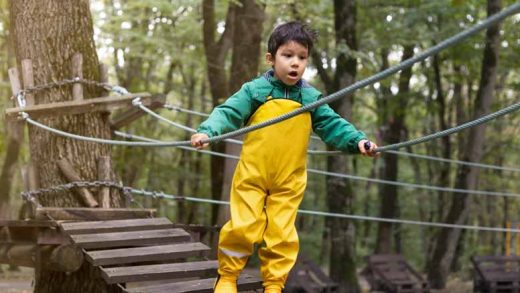Stories have been a cornerstone of early childhood education for a reason— they aid in the acquisition of important concepts that would otherwise be challenging to teach young children. It’s an arduous task, parents will admit, to get your child to sit still long enough to learn moral teachings or ideals. However, tales offer us an opportunity to teach kids these moral principles and lessons while keeping them delighted.
Few tales in the enthralling world of children’s literature have the same lasting impact as “The Giving Tree.” This classic story, written by the renowned Shel Silverstein, has captured the hearts of people of all ages and transcended decades with its inspiring message of unselfish love and kindness. This blog article explores the core of “The Giving Tree,” its influence on developing brains, the profound lesson it teaches, and the reasons behind the book’s ongoing appeal. The English version of “The Giving Tree” narrative and its moral lessons for young readers have been discussed in this article.
Origin And History Of The Giving Tree
“The Giving Tree” is a wonderful, heartfelt children’s story that teaches a valuable lesson. The narrative began with an American children’s picture book written by Shel Silverstein. After Harper & Row unleashed the story in 1964, it ascended to distinction as one of Silverstein’s most well-known works.
Story Type Of The Giving Tree
The children’s book “The Giving Tree” teaches us to care for others and to be grateful for all our loved ones do for us. Children will benefit from reading this story as they grow emotionally and acquire new vocabulary.
Story Summary
Let us examine the synopsis of “The Giving Tree.”
The narrative is about the friendship and lives of an apple tree and a little child, who grow to have a lovely bond. The boy soon develops into a “receiving” young child, then a teenager, a middle-aged man, and finally an elderly man because of the tree’s incredibly “giving” character. The boy in the narrative grows older, but throughout the entirety of his life, the tree refers to him as a “boy.”
The boy used to love playing with the tree, climbing up its trunk, dangling from its branches, eating its apples, and a lot of other activities. However, the boy visits the tree less and less as he gets older, usually just when he needs material goods at certain points in his life. Every time, the tree tries to please the child by giving him pieces of itself, which he may use to create tangible objects, such as money (from apples), a house (from branches), and a boat (from the trunk). “The tree was happy” both during and after each yielding stage.
Ultimately, the kid and the tree experience the pain of their corresponding natures of “taking” and “giving.” The youngster reappears by the tree’s side as an older man who has become fatigued, with only a stump left. The tree informs the youngster that it can no longer give him materials, fruit, or shade as it once did. Ignoring this, the child states that “a quiet place to sit and rest” is all he needs right now. The donating tree, a frail stump, nods in agreement upon hearing this. The tree was joyful once again in this last round of gifting.
The Giving Tree Story
The touching bond between a little child and a selfless tree is at the centre of this story. The boy’s life experiences are chronicled throughout the novel, as are his changing demands and the tree’s constant commitment to meeting them. The tree represents the spirit of unwavering love and infinite giving, affording the youngster warmth, shade, and branches for his creative play.
The Giving Tree Story Book
“The Giving Tree” is more than just a tale; it’s a beloved children’s book that has become a mainstay on family bookcases everywhere. Silverstein’s colourful pictures and deft narration combine to create a visual and literary feast for young readers. The timeless story of kindness and sacrifice is brought to life in the colourful pages, making it an essential addition to any child’s library of books.
The Evolution of the Boy-Tree Relationship
The boy’s wants deepen as he approaches adolescence and maturity. But the tree doesn’t waver in its dedication to the boy’s pleasure. The tree makes more and more substantial contributions, from apples that the child may sell for money to its trunk, which can be used to build a boat. The transformational power of unselfish giving and the sacrifices that love frequently requires are vividly depicted in this development.
The Giving Tree Story
Amid the boy’s ceaseless demands, readers are asked to consider the essence of generosity. Even though it is slowly running out of resources, the tree finds satisfaction and delight in taking care of the youngster. This begs the critical question, “What is generosity really all about, and how does it show up in our relationships?”
What Is the Moral of the Story The Giving Tree
As parents, teachers, and carers, we are responsible for assisting young readers in deriving the deep morals from “The Giving Tree.” Fundamentally, the narrative teaches an important lesson about the enduring power of unselfish giving and the return of love. Despite appearing never-ending, the tree’s sacrifices represent the happiness that follows sincere deeds of kindness.
Navigating the Complexity of Emotions
In “The Giving Tree,” Silverstein skillfully conveys a range of emotions, providing readers with a sophisticated examination of love, thankfulness, and the paradoxical nature of relationships. The boy’s reactions to the tree’s steadfast devotion range from happy laughter in times of plenty to feelings of regret and introspection as he realises the magnitude of the tree’s sacrifices.
The Giving Tree Story Summary
After analysing the story, we discover that “The Giving Tree” is a sophisticated investigation of the relationships between giving and receiving rather than a sentimental tale about selflessness. Relationships inevitably evolve; the tree’s journey from a rich, healthy creature to a bare stump is a metaphor for this. Children get an understanding of the delicate balance between taking and giving via the perspective of this narrative.
The Enduring Popularity of “The Giving Tree”
Even after it was first published decades ago, “The Giving Tree” still piques young readers’ curiosity. Its timeless ideas and very moving story make it a beloved classic for literary conversations, bedtime stories, and classrooms. The story’s ageless relevance and capacity to spark thought-provoking discussions on compassion and selflessness are the reasons for its enduring appeal.
The Giving Tree Story Book
Educators and parents may open up conversations on empathy, thankfulness, and the value of relationships above material belongings by including “The Giving Tree” in our kids’ reading regimens. Age barriers are irrelevant when it comes to Silverstein’s narrative, which makes it a useful tool for educating young people about timeless ideals.
What Lesson Will Your Child Learn From This Story?
Your youngster will learn several lessons from “The Giving Tree,” including “loving someone unconditionally without expecting anything in return” and “joy of being with your loved ones.”
The boy and the tree in the narrative have a relationship similar to that of a kid and a parent. Initially, the youngster has a deep affection for the tree, which the tree returns. However, as the youngster gets older, his priorities shift in line with his age, and he spends less time at the tree.
Nevertheless, the ancient tree’s attachment to the youngster never wavers. Even after the youngster has grown up, the tree still calls him a “boy” and shows him loving affection. The tree resembles a secure sanctuary where the youngster may hide and always know he is loved and accepted.
How Can Children Apply The Lesson Of The Story In Their Real Life?
The children may use this short story’s lesson to their advantage by making a point of always praising the people in their lives. Parenting requires us to gently guide our children towards developing the habit of loving our loved ones without conditions and without expecting anything in return. Teaching kids that happiness comes from doing simple things like spending time with our loved ones is essential.
In conclusion, “The Giving Tree” proves the narrative’s timeless ability to mold young brains and impart moral principles. Shel Silverstein’s masterwork asks readers to consider the actual meaning of giving and selflessness, as well as the significant influence of our actions on those we love, through its vibrant characters and emotionally packed plot. Revisiting the pages of this well-loved book serves as a gentle reminder that, similar to the giving tree, giving without expecting anything in return frequently results in the greatest happiness. We hope that this story taught your youngster a valuable lesson while also enhancing their reading abilities.
For more such interesting blogs, Visit Kangaroo Kids









